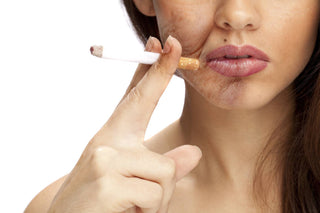Despite the well-documented and publicized health risks of lighting up, 19% of adults still smoke cigarettes.
Even graphic television ads that portray the negative consequences of smoking don’t sway many smokers to kick their intractable habit.
But, a new study conducted on identical twins may provide the impetus to change smokers’ behavior. That’s because researchers found that the smoking twin had earlier signs of skin aging when compared with their non-smoking counterpart.
A number of studies have demonstrated that smoking is an independent lifestyle factor associated with facial aging. However, few studies have determined what parts of the face are affected the most by smoking.
"Smokers are likely to get bags under their eyes and wrinkles around their lips earlier than non-smokers."
To better understand how smoking affects skin aging, researchers at the Department of Plastic Surgery at Case Western Reserve University obtained comprehensive medical and lifestyle information on identical twins. The Twins Day Festival, the largest annual gathering of twins and multiples in Twinsburg, OH provided the perfect opportunity to study this topic.
Medical and lifestyle information was obtained on 79 sets of identical twins between 2007 and 2010. The sets were broken into two groups: 1) one twin was a smoker and the other had never smoked or 2) within a twin set, both were smokers with at least a 5-year difference in duration of smoking.
The majority of twin sets were women (72%), ranging in age from 18 to 78 years (average age 48) with a mean Body Mass Index (BMI) of 27.8. Standardized photographs were also taken of each twin.
Three trained judges, who didn’t know which twin smoked, independently analyzed each of the twins’ photographs for evidence of facial wrinkles (forehead wrinkles & lines, crow’s feet, upper & lower lip lines, nasolabial crease) and aging around the eye area (upper lid skin redundancy, lower lid bags & pigmentation, malar bags, jowls). Each area was scored based on the extent of wrinkling and aging.
In comparing the smoking and non-smoking twin pairs, no major differences were found in sunscreen use, alcohol intake and perceived work stress which could account for facial aging differences.
Starting in the upper third of the face, researchers did not find any differences in wrinkle severity for lines in the forehead or between the eyebrows (vertical glabella lines). Also, there were no differences in the depth of crow’s feet. However, in the periorbital and lower third of the face, smokers generally had worse scores than non-smokers.
When compared with their nonsmoking counterpart, the smoking twin had worse scores for upper lid skin redundancy, lower lid bags, malar bags (swollen skin in the lower eyelid and on the cheek), upper lip vertical lines, lower lip vermillion wrinkles, nasolabial creases and jowls. In looking at twins with at least a 5-year difference in smoking duration, the twin who smoked longer had worse scores for these facial features.
Twin Photographs: See more examples of aging here
When making a global assessment of each twins face, the smoking twin was indentified with appearing older 57% of the time. For the twin sets where both smoked, the twin who smoked more than 5 years longer than the counterpart, was identified as appearing older 63.7% of the time.
Other Environmental Factors that Contribute to Aging
Previous to this study, the plastic surgery group conducted another aging study using data collected from 186 pairs of twins during 2006 and 2007.
The study confirmed that aging and sun exposure have deleterious effects on the skin. Marital status (divorced women), alcohol consumption and the use of antidepressants also increased the perceived age of individuals. Increased BMI in younger twins led to an older appearance, whereas as twins increased in age, a higher BMI led to a decrease in perceived age.
Study author Dr. Guyuron said, “This study provides strong statistical evidence to support the role of some of the previously recognized as well as several unrecognized factors that may accelerate an aged appearance.”
The Bottom Line
Appealing to our sense of beauty (and vanity) may be a greater motivator for quitting smoking than the long-term negative consequences of smoking. Even if you or a loved one has smoked for years, each passing hour, day, month and year that you quit adds years to your life. You can benefit from stopping smoking at any time.
Benefits & Tips on How to Quit Smoking
Dermatologists and plastic surgeons have known for years that smoking causes damage and promotes aging of the skin. That’s because toxins from smoking can speed up the breakdown of collagen and smoking reduces the amount of oxygen going to the skin.
If you’re considering having cosmetic surgery to correct some of the damage smoking has caused, you should be aware that many plastic surgeons will not perform surgery on smokers. That’s because smokers generally have a more difficult time healing. Smoking generates a significant source of free-radicals which may impair the repair mechanisms in the skin and may impair new collagen and elastin development.
The Great American Smokeout takes place each year on the third Thursday in November. If not for the health of your lungs, heart and other organs why not quit smoking for the health of your skin?

